Lead Pricing
| Interior | Outside | Balcony | Suite |
|---|---|---|---|
| Request Price | Request Price | Request Price | Request Price |

At Aurora Expeditions wilderness is a passion they share with others by taking small groups of like-minded people to some of the most isolated places on our planet. From the polar regions of Antarctica and High Arctic to the wilds of Costa Rica, Scotland, Patagonia and more, Aurora Expeditions aims to create special expedition-style cruises that foster an understanding and appreciation of our natural world.
The Australian-owned adventure company was initially established in the early 1990¹s by adventures Greg Mortimer and Margaret Werner when they began sharing their love of remote places by organising ship-based trips for keen friends and fellow travellers. Their style to push the boundaries¹ has remained unchanged and they are proud of the fact that their spirit of adventure and exploration is as strong as ever. Their adventure activities are proof of this; with many of their voyages offering polar scuba diving, sea kayaking, camping and mountain climbing.
Deeply committed to education and preservation of the environment, Aurora Expeditions were the founding member of both the International Association of Antarctic Tour Operators (IAATO) and the Association of Arctic Expedition Cruise Operators (AECO). All their voyages have expert expedition staff who will help to unlock the wonders of these special places.
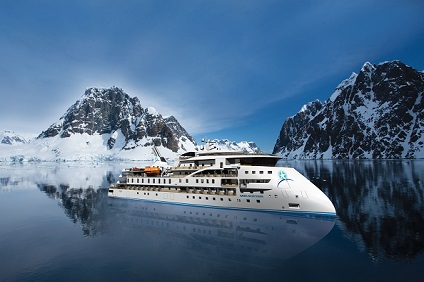
Deck: 3 | Quantity: 15 | Size: 23.2 m2
Cabin Features
Twin or double bed
Private En-suite
Porthole window
Desk area
Closet space
Sofa bed (can sleep 3rd passenger in select cabins)
Room-controlled thermostat
Safe for storing valuables
42″ flat-screen TV
Deck: 3 | Quantity: 15 | Size: 23.2 m2
Cabin Features
Twin or double bed
Private En-suite
Porthole window
Desk area
Closet space
Sofa bed (can sleep 3rd passenger in select cabins)
Room-controlled thermostat
Safe for storing valuables
42″ flat-screen TV
Decks: 4 & 6 | Quantity: 58 | Cabin and balcony combined size: 16.1m2 – 21m2. Cabin Features Twin or double bed Private En-suite Floor to ceiling window Desk area Closet space Private balcony Room-controlled thermostat Safe for storing valuables 42″ flat-screen TV
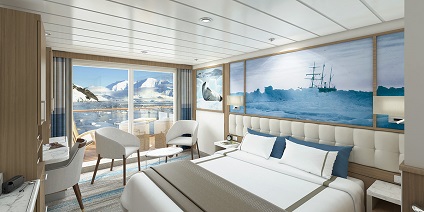
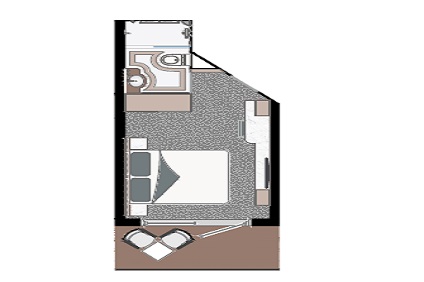
Decks: 4 & 6 | Quantity: 58 | Cabin and balcony combined size: 16.1m2 – 21m2. Cabin Features Twin or double bed Private En-suite Floor to ceiling window Desk area Closet space Private balcony Room-controlled thermostat Safe for storing valuables 42″ flat-screen TV
Decks: 4 & 6 | Quantity: 58 | Cabin and balcony combined size: 16.1m2 – 21m2. Cabin Features
Twin or double bed
Private En-suite
Floor to ceiling window
Desk area
Closet space
Private balcony
Room-controlled thermostat
Safe for storing valuables
42″ flat-screen TV
Deck: 4 | Quantity: 2 | Cabin and balcony combined size: 30.5m2 – 40.2 m2.
Cabin Features
Twin or double bed
Private en-suite
Full size window
Desk area
Closet space
Private balcony
Room-controlled thermostat
Safe for storing valuables
42″ flat-screen TV
Deck: 7 | Quantity: 4 | Cabin and balcony combined size: 38.9 m2. Cabin Features
Twin or double bed
Private en-suite
Full size window
Desk area
Closet space
Private balcony
Room-controlled thermostat
Safe for storing valuables
42″ flat-screen TV
Seperate lounge area
Deck: 4 | Quantity: 1 | Cabin and balcony combined size: 44.5 m2. Cabin Features
Twin or double bed
Private en-suite
Full size window
Desk area
Closet space
Private balcony
Room-controlled thermostat
Safe for storing valuables
Seperate lounge area
42″ flat-screen TV


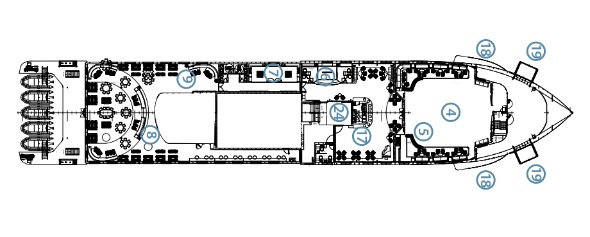

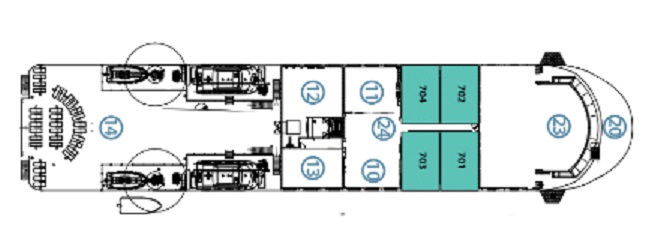
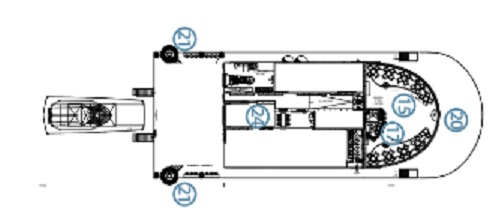
Aurora Expeditions is excited to be launching their new ship, the Greg Mortimer, ready for the Antarctic season in, 2019.
Proudly named after Aurora’s adventurous co-founder, this 104-metre ship is Aurora’s very first, purpose-built expedition vessel. Capable of negotiating the strongest winds and waves, the Greg Mortimer is built to world-class polar standards – designed in close consultation with their expedition specialists, taking advantage of more than 27 years of experience.
Whether it’s adventure, wildlife or simply relaxing that draws you to the planet’s wildest places, the Greg Mortimer will deliver the best expedition cruising experience. The Greg Mortimer will continue to retain Aurora’s ethos and focus on multiple landings, flexible itineraries, environmental sensitivity and family-built atmosphere.
Ship Profile & Stats
- Length: 104 metres
- Tonnage: 7,400
- Maiden Voyage: 2019
- Passenger Capacity (dbl): 160
- Ship Registration: Bahamas
Ship Facilities
- Ship Shop
- Lounge / Lecture Theatre
- Reception
- Change Room / Mudroom
- Zodiac Landing Platforms
- Activity Launching Platform
- Dining Room
- Photography & Art Room
- Library
- Gym
- Sauna / Wellness Centre
- Sun Deck
- Observation Lounge
- Top Deck
- Bars
- Viewing Platforms
- Hydraulic Platforms
- Observation Deck
- Jacuzzis / Plunge Pools
- Medical Centre

Cruise Itinerary
| Date | Activity | Arrive | Depart |
|---|---|---|---|
| 01 Aug '22 | Reykjavik, Iceland |
Hotel | |
| 02 Aug '22 | Reykjavik, Iceland |
Embark | |
| 03 Aug '22 | Stykkisholmur, Iceland |
||
| 04 Aug '22 | Westfjords, Iceland |
||
| 05 Aug '22 | Westfjords, Iceland |
||
| 06 Aug '22 | Akureyri, Iceland |
||
| 07 Aug '22 | Grimsey Island Iceland |
||
| 07 Aug '22 | Husavik, Iceland |
||
| 08 Aug '22 | Mjoifjordur, Iceland |
||
| 09 Aug '22 | Hofn, Iceland |
||
| 10 Aug '22 | Westman Islands (Vestmannaeyjar), Iceland |
||
| 11 Aug '22 | Reykjavik, Iceland |
Disembark |
All itineraries and ports of call at the discretion of the cruise line subject to local weather conditions and may change without notice.
10 Night Cruise sailing from Reykjavik roundtrip aboard Greg Mortimer.
Day 1 – Arrive in Reykjavik and make your own way to our group hotel.
Accommodation: Fosshotel (or similar)
Day 2 – Embark the Greg Mortimer / Hvalfjördur
After breakfast at the hotel, a transfer is included to the pier to board our ship, the Greg Mortimer. Sail into Hvalfjördur, a beautiful fjord just north of Reykjavik with wide areas of flat verdant land along majestic mountains, and beaches cut with creeks. The fjord is approximately 30 kilometres (19 miles) long and five (three miles) kilometres wide. The area is rich in bird life and is home to seals, perfect for Zodiac cruising, kayaking and hikes.
Historically, Hvalfjörður was home to one of the main whaling stations in Iceland, with ships heading out into Faxaflói Bay. It was one of the most important naval stations in the North Atlantic during World War II, when Iceland was occupied by the Allies after the Nazis conquered Denmark. The old whaling station and a war museum can be found in the fjord.
Day 3 Stykkisholmur / Snaefellsnes Peninsula / Látrabjarg Cliffs
Stykkisholmur is the starting point of our adventures on the Snaefellsnes Peninsula, gateway Snæfellsjökull National Park. Stykkishólmur is located by Breiðafjörður Bay on the north of Snæfellsnes peninsula and is surrounded by wonderful views of the innumerable islands. One of the defining landmarks in Stykkishólmur are the old houses in the old city centre, some of which were owned by Danish traders, and every year in August there is a Danish town festival in Stykkishólmur called Danskir dagar or Danish days. The oldest house in Stykkishólmur is the Norwegian house, which dates back to 1832. The inhabitants take great pride in preserving the old houses and walking in the centre of town is like walking in another era.
An area of diverse landscapes, characterised by lava fields and glistening fjords and home to bird-rich Breidafjordur Bay. The area is crowned by the magnificent, ice-capped Snæfellsjökull volcano, a 700,000-year-old dormant subglacial volcano, visible from Reykjavik on a clear day and immortalised in Jules Verne’s Journey to the Centre of the Earth.
Disembark the ship at approximately 8.30 am to commence today’s full day (7 hours) excursion visiting the following areas:
Arnarstapi was an important trading post in the past and had a much bigger population than it has now. Columnar basalt, ravines and grottoes surround the Arnarstapi pier. There is a large arctic tern colony in the village itself, and a walk along the coastline is a great way to see birds such as kittiwake, Arctic tern and fulmar. You will also pass magnificent lava formations. The seaside and the cliffs between Arnastapi and Hellnar were made a Natural Reserve in 1979. A sculpture of Bardur Snaefellsas by Ragnar Kjartansson stands by the beach at Arnarstapi.
At Bjarnarhöfn you will enjoy a guided tour of the shark museum and have the opportunity to taste the famed cured shark.
Though Grundarfjörður is not the most well-known town in Snæfellsnes, Mount Kirkjufell is certainly one of the most famous mountains in Iceland, if not the world. It is not unusual for photographers from all over the world to make their way to Grundarfjörður for the sole purpose of photographing this unique landmark which has even starred in a number of films. However, there is a lot more on offer in Grundarfjörður than just Mount Kirkjufell. Nature abounds, with vibrant birdlife and spectacular waterfalls.
En route to Isafjordur, we sail past the immense Látrabjarg cliffs, Iceland’s westernmost point and home to a huge population of razorbills and puffins.
Days 4-5 Westfjords
Over the next two days, explore the Westfjords region featuring outstanding landscapes with jaw-dropping views of dramatic fjords carved by ancient glaciers, sheer table mountains that plunge into the sea and pristine North Atlantic vegetation. The region features attractive towns such as Isafjordur, the famous Dynjandi waterfall, and spectacular fjords offering kayaking excursions, hiking trails, and bird-watching.
In genuine expeditionary style, we keep our itinerary flexible to allow for spontaneity. We plan to visit Hornstrandir peninsula, one of Iceland’s remotest and most pristine regions filled with many deep and dramatic fjords, towering bird cliffs, stunning natural beauty and opportunities for wildlife encounters. Enjoy the bountiful silence and magnificent landscapes seen by the few adventurers that make their way here.
Day 6 Akureyri and Mývatn
Picturesque Akureyri is Iceland’s second largest city outside the capital area with a superb snow-capped mountain backdrop. Explore the old town, with its beautifully maintained period houses before heading inland to nearby Mývatn region – an area said to be the most geologically active area in Iceland.
Day 7 GrÃmsey Island / Húsavik
Located approximately 40 km (25 miles) off the mainland, GrÃmsey is a verdant grassy island, probably best known for its proximity to the Arctic Circle, which cuts across the island. Many people travel to GrÃmsey just to say they have stepped across the imaginary line. With a tiny population of approximately 100 inhabitants, it’s a fantastic place for Zodiac cruising, kayaking, and photographing seabirds such as guillemots, gulls and puffins.
Leaving GrÃmsey to return closer to the mainland, we spend time scanning the waters of Skjálfandi Bay around Húsavik, a town known as the Iceland’s ‘whale watching capital’, home to up to 24 different whale species, as well as dolphins and 30 variety of birds. The largest animal on earth, the blue whale, has also been spotted in Skjálfandi Bay, and if you are lucky, you might catch a glimpse of this magnificent creature as well as others, such as orcas, fin whales and pilot whales.
Day 8 Mjóifjördur
Mjóifjördur (meaning narrow fjord) is an 18 km / 11 mile fjord on Iceland’s east coast length is a little-known gem cherished by locals. Hidden between Nordfjördur and Seydisfjördur mountains that provide shelter and pleasant weather, the fjord is known by locals as an excellent place to soak in the peaceful surroundings and for its spectacular waterfalls – ideal for kayaking and Zodiac cruising.
Mjóifjörður is an exceptionally beautiful, tranquil and remote area with spectacular cliffs, and because of the fjord’s still weather it has lush green hills and exceptionally rich flora lining its shores. It also has the impressive Prestagil (The Priest’s Ravine) and the Hofsárgljúfur Canyon with delightful rivers and waterfalls. If it weren’t for the weekly ferry that comes here once a week in the winter, the local people would be completely isolated. At Asknes are the remains of an old whaling station, the largest in the world at the time, built by the Norwegians around 1900, with over 200 hundred workers. Today, on the way to the tiny village, Brekkuþorp, where only about 20 people live, a shipwreck on the shore acts as a haunting reminder of the town’s whaling past.
Day 9 Hofn & Vatnajökull National Park
Höfn is a lively fishing town with a healthy population of 1,800, and gateway to Vatnajökull National Park – one of the most spectacular and special parts of Iceland, home to Europe’s largest glacier, Vatnajökull – our shore excursion for the day. We’ll also hike in Skaftafell National Park, which was established in 1967, but from 2008 it became part of the larger Vatnajökull National Park, Europe’s second largest after Yugyd Va in Russia. The park also boasts colourful mountains and deep valleys, as well as rich birdlife, reindeers and seals.
Inside the national park you can find glacier tongues resting on the green fields of the lowland, Jökulsárlón glacier lagoon, a glacial lagoon filled with floating icebergs that wash up on shore and stand gleaming on the nearby black-sand beach, dubbed Diamond beach. Enjoy an amphibian boat excursion on the lagoon to photograph the icebergs.
Day 10 Westman Islands
Located off Iceland’s south coast, the Westman Islands (Vestmannaeyjar) were formed by volcanic eruptions around 10,000 years ago. Sail past Surtsey Island, a UNESCO World Heritage site that emerged from the sea in 1963 and is one the youngest land masses on earth. Westman Islands are surrounded by 15 other uninhabited islands and around 30 rocks and skerries offering refuge for rich array of seabirds. Westman Islands are considered to have the largest Atlantic puffin colony in the world, and when sailing around the islands it is not uncommon to see puffins but also whales and seals.
Heimaey is the main island in the archipelago and it has the population of around 4,200. Ashore on Heimaey, the only inhabited island in the archipelago, we see half-buried houses that remain from a violent 1973 eruption of Eldfell volcano, which you can hike up if you wish. A visit to the weather station offers bird-watching opportunities and splendid views of the surrounding islands.
Eruptions are a big part of the history of the Westman Island, where there are two volcanoes – one that erupted some 6,000 years ago, and Mount Eldfell that erupted in 1973, forcing all of the island’s inhabitants to evacuate for the mainland. Serendipitously, due to bad weather the day prior to the eruption, all the fishing boats remained in the harbour and were able to help transport Heimaey’s inhabitants to the mainland. You can learn more about the story of the eruption and the aftermath at the fascinating Eldheimar museum, which includes a display of a house that was buried in ash during the eruption.
Day 11 Disembark Reykjavik
After breakfast, bid farewell to the expedition team, crew and newfound friends as you disembark in Reykjavik.
